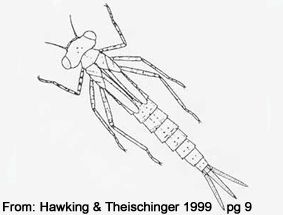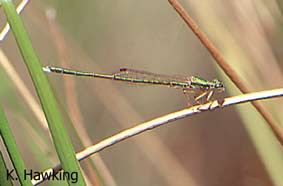Major Group: Insecta
Order: Odonata
Family: Hemiphlebiidae
Genus: Hemiphlebia
Species: mirabilis
This family is represented in Australia by a single genus, Hemiphlebia mirabilis. |
Descriptive Features: slender body, pale to dark greyish brown
antennae bare, 7-segmented
median lobe of labium with elongate curved processes (paraglossae), with strong seta near base of each
legs strongly banded with darker grey, femora with at least 2 conspicuous dark bands
caudal gills flat, entire, held with edges uppermost, basal fracture line very well defined; main tracheal trunks central, branch tracheae oblique with few branches
Total length: up to 18 mm |

|
Hemiphlebia mirabilis |
|
|

|
Hemiphlebia mirabilis |
|
Taxonomic Checklist:
Hemiphlebiia mirabilis Selys, 1869 |
|
Distribution: SE Vic; this species has only been recorded from Wilsons Promotory National Park.
Sensitivity Rating: none
Functional Feeding Group: predators |

|
Kings Lake, Mildura Vic |
|
|
Ecology: Adults are commonly known as 'greenlings'.
Instream habitat: Hemiphlebiia nymphs occur in permanent ponds and swamps.
Feeding ecology: Nymphs are predators on a wide range of small invertebrates.
Habit:
Life history: Females probably insert eggs into aquatic vegetation. Eggs may be able to withstand drought. Adults are present from late November to late February. Hemiphlebia mirabilis is univoltine. |
| |
Information Sources: Sant & New 1988, Houston 1988, Houston & Watson 1999, Silsby 2001, Birkin et al. 1993, Theischinger & Hawking 2006 |
|
|
|